Bennemann K.H., Ketterson J.B. Superconductivity: Volume 1: Conventional and Unconventional Superconductors; Volume 2: Novel Superconductors
Подождите немного. Документ загружается.

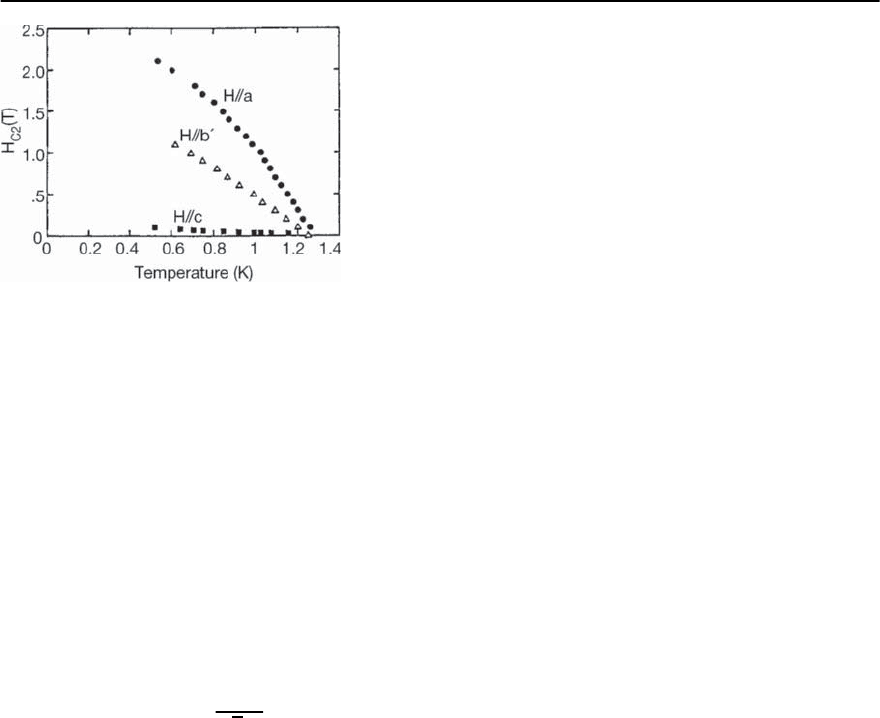
1190 M. Lang and J. M¨uller
Fig. 20.33. Upper critical fields B
c
2
determined from re-
sistivity measurements as a function of temperature for
(TMTSF)
2
ClO
4
for the three principal crystal axes [248]
shows the temperature dependence of the upper crit-
ical fields, B
c
2
(T), for (TMTSF)
2
ClO
4
as determined
by early resistivity measurements [248]. The B
c
2
(0)
values of 2.8 T, 2.1T and 0.16 T for the a-axis, b-axis
and c -axis, respectively, have been obtained from the
data of Fig.20.33 by an extrapolation to zero temper-
ature.The so-derived value for fields aligned parallel
to the a-axis, where B
c
2
is the largest, is close to the
Pauli limiting field B
P
which is the critical value re-
quired to break spin-singlet (S = 0) Cooper pairs. For
a non-interacting electron gas this is the case when
the Zeeman energy just equals the condensation en-
ergy, i.e.
B
P
=
0
1
√
2
B
, (20.15)
where
B
denotes the Bohr magneton [249,250]. As-
suming a BCS ratio for the energy gap
0
=1.76 k
B
T
c
yields B
P
(in Tesla) = 1.84 × T
c
(in K) = 2.3 T for
(TMTSF)
2
ClO
4
. The fairly good coincidence with
the experimentally derived critical field has been
taken as an indication for a spin-singlet pairing state
[248,251, 252]. As will be discussed in more detail
in Sect. 20.4.5, more recent resistivity measurements
on the pressurized X = PF
6
salt down to lower tem-
peratures revealed upper critical field curves which
show an upward curvature for T → 0 with no sign
of saturation down to 0.1 K [253].It has been argued
in [253] that this unusual enhancement of B
c
2
which
exceeds the Pauli paramagnetic limit by a factor of 4
is strongly suggestive of a spin-triplet (S=1) pairing
state.
Yet fromtheinitial slopes of theupper critical field
curves in Fig.20.33,B
i
c
2
,the Ginzburg–Landau coher-
ence lengths
i
(0) can be derived using the following
relation: B
i
c
2
=
0
/(2
j
k
T
c
), where i, j and k can be
a,b and c [205,206]. The so-derived
c
value of about
20 Å being much smaller than the numbers for the a-
axis and b -axis coherence lengths of 700Å and 335 Å
respectively, but comparable to the lattice parameter
c =13.5Å indicates that superconductivity has, in
fact,a more quasi-2D character.For the London pen-
etration depth for B parallel to the a-axis, the axis of
highest conductivity, a value of
¯
=40m has been
reported [254]. This number exceeds the GL coher-
ence lengths by orders of magnitude indicating that
the present system is an extreme type-II supercon-
ductor.
(BEDT-TTF)
2
X and (BEDT-TSF)
2
X Salts
Due to the strong effects of fluctuations in these su-
perconductors of reduced dimensionality, an accu-
rate determination of the upper critical fields is dif-
ficult and in many cases not free of ambiguities. This
holds true in particular for resistivity measurements
in finite fields aligned perpendicular to the highly
conducting planes as phase fluctuations of the order
parameter give rise to a resistive state which tends to
descendfar belowthe mean-fieldtransition tempera-
ture.A more reliable way to determine the upper crit-
ical fields is provided by measuring thermodynamic
properties and employing a fluctuation analysis as
described in Sect. 20.4.1. The left panel of Fig. 20.34
shows B
c
2
curves for -(ET)
2
Cu[N(CN)
2
]Br as deter-
minedfrom dc-magnetizationmeasurements[9,207]
using (20.11), cf. Figs. 20.29 and 20.30. The B
c
2
(T)
curve for B aligned parallel to the highly conducting
planes as determined from resistivity measurements
are shown in the right panel of Fig. 20.34 over an ex-
tended field range. For the layered superconductors
with negligible in-plane anisotropy, the expression
(20.9) can be used to determine the GL coherence
lengths perpendicular and parallel to the conduct-
ing planes.
Table 20.2 compiles the B
c
2
values together with
other superconducting parameters for the above
BEDT-TTF compounds. For comparison, the table
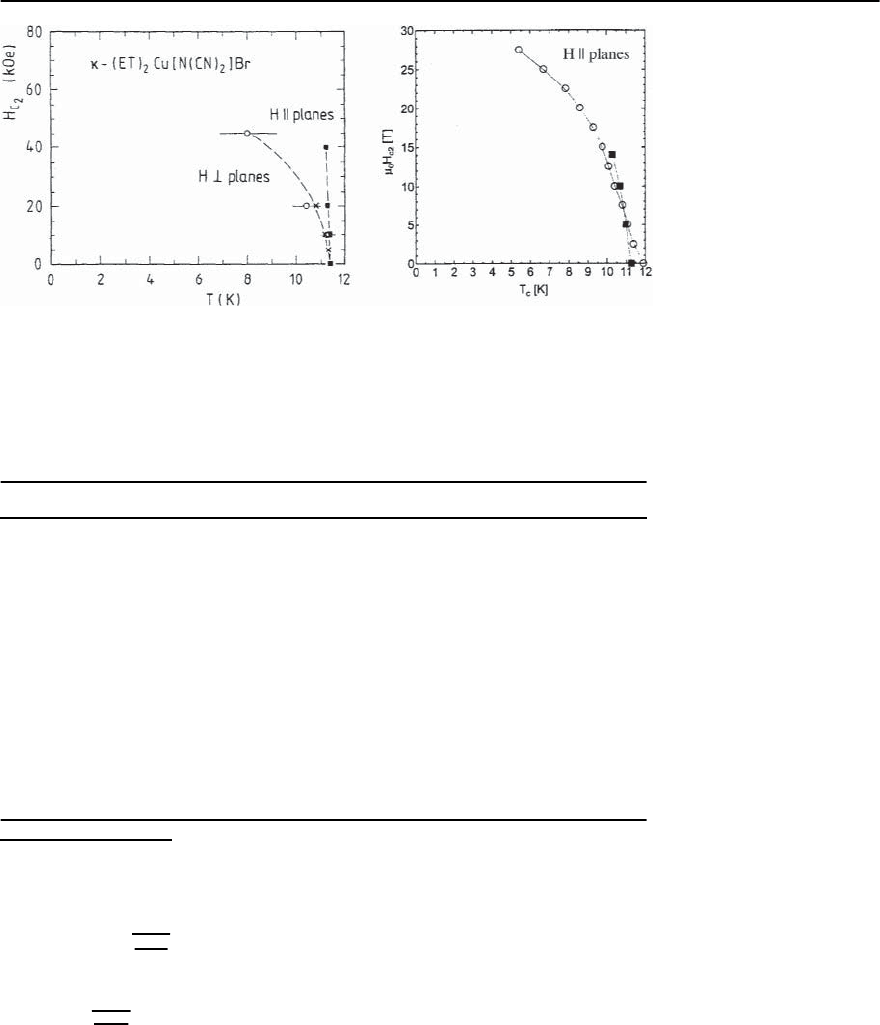
20 Organic Superconductors 1191
Fig. 20.34. Upper critical fields of -(ET)
2
Cu[N(CN)
2
]Br. Left panel:anisotropyofB
c
2
as a function of temperature as
determined from dc-magnetization measurements, taken from [207]. Right panel: B
c
2
(T) for fields aligned parallel to
the conducting planes as determined from resistivity measurements using different criteria (closed and open symbols),
reproduced from [255]
Table 20.2.Superconducting-state parameters of two representative -phase (ET)
2
Xsalts
X=Cu(NCS)
2
and Cu[N(CN)
2
]Br as well as -(BETS)GaCl
4
-(ET)
2
Cu(NCS)
2
-(ET)
2
Cu[N(CN)
2
]Br -(ET)
2
GaCl
4
T
c
8.7 ∼ 10.411.0 ∼ 11.85∼ 6
B
⊥
c
2
(0) (T)
13
68∼ 10 3
B
c
2
(0) (T)
14
30 ∼ 35 > 30 12
B
⊥
c
1
(0) (mT)
15
6.5 3
B
c
1
(0) (mT)
16
0.2
B
c
th
(0) (mT)
17
54 65
⊥
(0) (Å)
18
5 ∼ 95∼ 12 9 ∼ 14
(0) (Å)
19
53 ∼ 74 28 ∼ 64 143
(0) (Å)
20
74 60 105
⊥
(0) (m)
21,22
40 ∼ 200 38 ∼ 133
(0) (Å)
23
5100 ∼ 20000 6500 ∼ 15000 1500
24
100 ∼ 200 200 ∼ 300 107
13
[9,256–258]
14
[255,258–261]
15
[39,262]
16
[39]
17
B
c
th
(0) = T
c
·
0
2 V
mol
18
[9,39,187,207,256,258,263]
19
[9,39,207,258,263]
20
(0) =
0
2 B
⊥
c
2
21
⊥
and
denote the screening of supercurrents flowing perpendicular and parallel to the conducting planes, respec-
tively, and not the direction of the magnetic field.
22
[263–265]
23
[256,263,265–269]
24
[9,256]
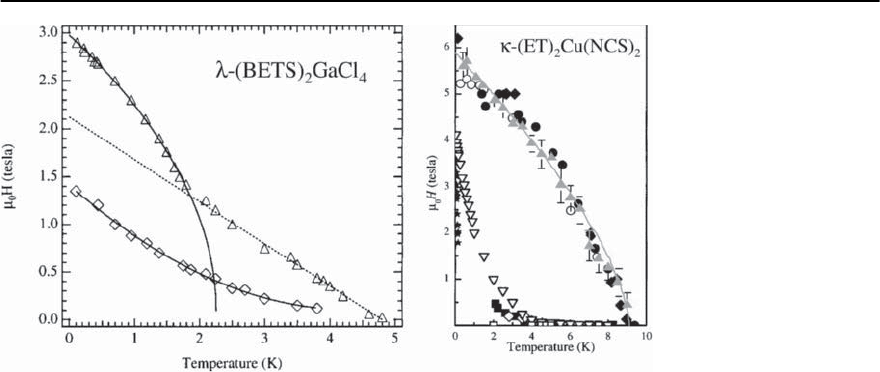
1192 M. Lang and J. M¨uller
Fig. 20.35. Left panel: Upper critical field for B ⊥ to the planes (triangles)of-(BETS)GaCl
4
. Upper solid cur ve is
B
c
2
∝ (T
∗
− T)
1/2
;thedashed curve B
c
2
∝ (T
c
− T)(seetext).Diamonds and the lower solid curve indicate the flux-lattice
melting line (see also Sect. 20.4.3). Right panel: B
c
2
(T)forB⊥ to the planes of -(ET)
2
Cu(NCS)
2
as determined from
different experimental techniques, see [256]. The solid curve is B
c
2
∝ (T
c
− T)
2/3
(see text).Also shown are transition and
crossover lines in the mixed state, cf. Figs.20.36 and 20.37 in Sect. 20.4.3 below.Reproduced from [256]
also contains data for the BETS-based system -
(BETS)GaCl
4
.As indicated in the table,the transition
temperatures reported in the literature show a con-
siderably large variation depending on the method
and criterion used to determine T
c
. This may partly
be related to the fact that the superconducting transi-
tion is usually found to be relatively broad. Even for
high quality single crystals with an in-plane mean
free path of typically ∼ 2000 Å [108], the transi-
tion can be broadened due to internal strain fields as
a consequence of the extraordinarily large pressure
dependence of T
c
.Inaddition,thequasi-2Dnature
of the electronic structure gives rise to pronounced
fluctuations which cause a rounding of the transi-
tion [10].
According to recent magnetoresistivity stud-
ies, the in-plane Fermi surface of -(BETS)GaCl
4
strongly resembles that of -(ET)
2
Cu(NCS)
2
with the
effective masses being almost identical for both com-
pounds [256]. However, the interplane transfer inte-
gral of t
⊥
≈ 0.21 meV for the BETS salt is about a fac-
tor of 5 larger [256], indicating that -(BETS)GaCl
4
is more three-dimensional. Figure 20.35 compares
the magnetic field-temperature phase diagrams of
the above compounds for fields aligned perpen-
dicular to the planes. A dimensional crossover has
been suggested to account for the unusual tempera-
ture dependence of B
⊥
c
2
(T) observed for the BETS-
based compound (left panel): B
c
2
(T) shows a 3D-
like linear behavior close to T
c
which turns into a
power-law dependence characteristic for a 2D super-
conductor with weakly coupled layers below some
crossover temperature labeled as T
∗
[10,256].Incon-
trast, B
c
2
(T) for the -(ET)
2
Cu(NCS)
2
salt follows a
B
c
2
(T) ∝ (T − T
c
)
2/3
over the whole temperature
range. The additional crossover and transition lines
in the mixed state below the B
c
2
(T)curvesindicated
in Fig. 20.35 will be discussed in Sect. 20.4.3.
Important information on the spin state of the
Cooper pairs can be gained by comparing the ex-
perimentally determined B
c
2
(T) for T → 0withthe
Pauli-limiting field, B
P
, as defined in (20.15). Using
this formula, which neglects any orbital effects, and
assuming a weak-coupling BCS ratio for the gap, i.e.
0
=1.76 k
B
T
c
, B
P
amounts to ∼ 18 T and ∼ 21 T
for -(ET)
2
Cu(NCS)
2
and -(ET)
2
Cu[N(CN)
2
]Br, re-
spectively. Apparently, these numbers are signifi-
cantly smaller than the B
c
2
(0) values found experi-
mentally and listed in Table 20.2. On the other hand,
clear evidence for a spin-singlet pairing state has

20 Organic Superconductors 1193
been inferred from Knight shift measurements on
-(ET)
2
Cu[N(CN)
2
]Br yielding a vanishingly small
spin susceptibility at low temperatures [257]. These
deviations might find a natural explanation by re-
calling that (20.15) is valid only in the weak-coupling
limit. For a strong-coupling superconductor, on the
other hand, the density of states is renormalized
leading to a Pauli field which is enhanced by a
factor of (1 + )
1/2
[205, 249], where denotes
the interaction parameter, see (20.14). Clear evi-
dence for a strong-coupling type of superconduc-
tivity has been found in specific heat experiments
on the -(ET)
2
Cu[N(CN)
2
]Br and -(ET)
2
Cu(NCS)
2
salts [49, 50, 233, 270], see Sect. 20.4.5. As an alter-
native mechanism to account for a B
c
2
(0) value in
excess of the Pauli field, a transition into a Fulde–
Ferrell–Larkin–Ovchinnikov (FFLO) state [271,272]
has been proposed [260,273] and discussed contro-
versially,see e.g.[10,274].In such a scenario,a super-
conductor with suitable materials parameter adopts
a new state at sufficiently high fields where the order
parameter is spatially modulated. A more detailed
discussion on this issue will be given in Sect. 20.4.3
below.
Besides T
c
and the upper critical fields, Table 20.2
contains further superconducting-state parameters
such as the lower and the thermodynamic critical
fields B
c
1
and B
c
th
, respectively, as well as the GL
coherence lengths
,⊥
and the London penetration
depths
,⊥
. B
c
1
is usually determined by measur-
ing the magnetization as a function of field under
isothermal conditions where B
c
1
corresponds to the
field above which flux starts to penetrate the sample.
Due to the smallness of B
c
1
, the plate-like shapes of
the crystals and the peculiar pinning properties of
these layered superconductors, an accurate determi-
nation of B
c
1
is difficult.A more reliable way to deter-
mine B
⊥
c
1
(0) has been proposed by Hagel et al. based
on a model for thermally activated flux creep yield-
ing B
⊥
c
1
(0) = (3 ±0.5) mT for -(ET)
2
Cu[N(CN)
2
]Br
[262]. The values for the thermodynamic critical
fields, B
c
th
, in Table 20.2 are estimated from specific
heat results using B
c
th
(0) = T
c
·
0
/(2 V
mol
)where
is the Sommerfeld coefficient.These values roughly
agree with those calculated from B
c
th
= B
c
2
/(
√
2) =
B
c
1
√
2/ ln ,where = / is the GL parameter.
The large numbers of reflect the extreme type-II
character of these superconductors.
Also listed in Table 20.2 are values of the mag-
netic penetration depth , the characteristic length
over which magnetic fields are attenuated in the su-
perconductor. While the absolute values for de-
rived from various experimental techniques are in
fair agreement within a factor 4 ∼ 5, no consensus
has yet been achieved concerning its temperature de-
pendence, see Sect. 20.4.5 below.
20.4.3 Mixed State
The peculiar material parameters of the present
organic superconductors such as the pronounced
anisotropy of the electronic states, the small coher-
ence lengths and large magnetic penetration depths
give rise to highly anomalous mixed-state properties
and a rich B-T phase diagram in the superconduct-
ing state. Exploring the unusual features of extreme
type-II layered superconductors continues to be a
subject of considerable interest owing to the vari-
ety of exciting phenomena that has been found in
these materials, see e.g. [275].Among them is a first-
order melting transition of the Abrikosov vortex lat-
tice into a vortex-liquid phase [276,277] not known
for usual 3D superconductors. One of the striking
early observations related to the anomalous mixed-
statepropertieswastheappearanceofaso-calledir-
reversibility line, B
irr
, which separates the B-T plane
into an extended range B
irr
< B < B
c
2
where the
magnetization is entirely reversible from a magneti-
cally irreversible state at B < B
irr
.Whenalayeredsu-
perconductor is exposed to a magnetic field B > B
c
1
aligned perpendicular to the planes,the confinement
of the screening currents to the superconducting lay-
ers results in a segmentation of the flux lines into
two-dimensional objects, the so-called vortex pan-
cakes [278]. The coupling between vortex segments
of adjacent layers is provided by their magnetic in-
teraction and the Josephson coupling. The latter in-
teraction drives tunneling currents when two vortex
segments are displaced relative to each other.As a re-
sult of both effects, the vortex pancakes tend to align
thereby forming extended stacks.

1194 M. Lang and J. M¨uller
A quitedifferent situation arises for fields aligned
parallel to the layers. In the limiting case of a quasi-
2D superconductor characterized by a cross-plane
coherence length
⊥
being smaller than the inter-
layer distance s, the vortex cores slip into the insulat-
ing layers where the superconducting order param-
eter is small. Such a Josephson vortex has an ellip-
tically deformed cross section and lacks a normal
core. Since the Josephson screening currents across
the insulating layers are very weak, the material is
almost transparent for fields parallel to the planes
corresponding to a large value for the upper critical
field B
c
2
, cf. Table 20.2. Below we will discuss some
of the anomalous mixed-state properties such as the
vortex-lattice melting transition, the irreversibility
line, the lock-in transition as well as the possible re-
alization of an anomalous high-field state.
Muon spin rotation measurements on the -
(ET)
2
Cu(NCS)
2
salt have shown that a 3D flux-line
lattice exists only at very low fields B < 7 mT [279].
25
Using a decoration technique, Vinnikov et al. suc-
ceeded in imaging the vortex lattice in the low-field
range [280].Upon increasing the field to above some
dimensional crossover field, B
2D
, the vortex lattices
of adjacent layers become effectively decoupled.The-
ory predicts that the crossover field is related to
the anisotropy parameter and the interlayer dis-
tance s by B
2D
=
0
/(
2
s
2
) [275], which for the -
(ET)
2
Cu(NCS)
2
salt results in B
2D
=7.3 ∼ 30 mT
[279,281]. An anomalous second peak in magneti-
zation curves indicating a redistribution of pancake
vortices at more suitable pinning centers, has been
associated with B
2D
[281,282]. According to mea-
surements of the interlayer Josephson-plasma reso-
nance [283],a long-range quasi-2Dorder among vor-
tices within the individual layers characterizes the
state above B
2D
and persists up to the irreversibility
line.InthisregionoftheB-T plane the pancake vor-
tices of adjacent layers become effectively decoupled
leading to a pinned quasi-2D vortex solid in each
layer with no correlations between the locations of
vortices among the layers [284]. A somewhat differ-
ent point of view is taken in [282, 286], where B
2D
marks the crossover from a 3D flux line lattice below
B
2D
to a state with less strong interlayer coupling on
a long range scale above, where a coupling between
the layers is, to some extent, still present.
Another striking property common to the present
quasi-2D superconductors is an extended vortex-
liquid phase above B
irr
. Here the magnetization be-
haves entirely reversible upon increasing and de-
creasing the magnetic field, indicating that in this
range flux pinning is ineffective. The abrupt on-
set of magnetic hysteresis at B ≤ B
irr
indicates a
drastic increase in the pinning capability. The tem-
perature dependence of the irreversibility field has
been studied in detail for -(ET)
2
Cu(NCS)
2
and -
(ET)
2
Cu[N(CN)
2
]Br using a variety of techniques
including ac-susceptibility [262], dc-magnetization
[207], magnetic torque [281, 287] or Josephson-
plasma-resonance experiments [283]. Figure 20.36
shows onalinear scaletheirreversibilitylinein the B-
T phase diagram of -(ET)
2
Cu(NCS)
2
deduced from
torque-magnetometry measurements in fields per-
pendicular to the planes [287]. As demonstrated in
the left panel of Fig. 20.36, the irreversibility field
at the lowest temperatures lies well below the up-
per critical field. Thus quantum fluctuations of the
vortices as opposed to thermally driven motions
are responsible for the vortex liquid state in this
region of the phase diagram [287]. The crossover
from quantum to thermal fluctuations manifests it-
self in the temperature dependence of B
irr
(T). Be-
low ∼ 1 K where quantum fluctuations are predom-
inant, B
irr
(T) varies linearly with temperature [287],
whereas in the thermal fluctuation regime an expo-
nential behaviorB
irr
= B
0
exp(−AT /T
c
) has been ob-
served above the dimensional crossover field B
2D
in
contrast to a power-lawbehavior in the3D vortex line
lattice region below B
2D
[207,281].A similar behav-
ior has been observed also for -(ET)
2
Cu[N(CN)
2
]Br
where the crossover in the temperature dependence
of the irreversibility line has been interpreted as a
crossover from 2D to 3D pinning [262].
Indications for a first-order phase transition as-
sociated with a melting and/or a decoupling of
the quasi-2D vortex lattice near the irreversibil-
ity line, similar to what has been found in some
25
Here the sample was arranged so that the superconducting planes enclose an angle of 45
◦
in respect to the magnetic
field.
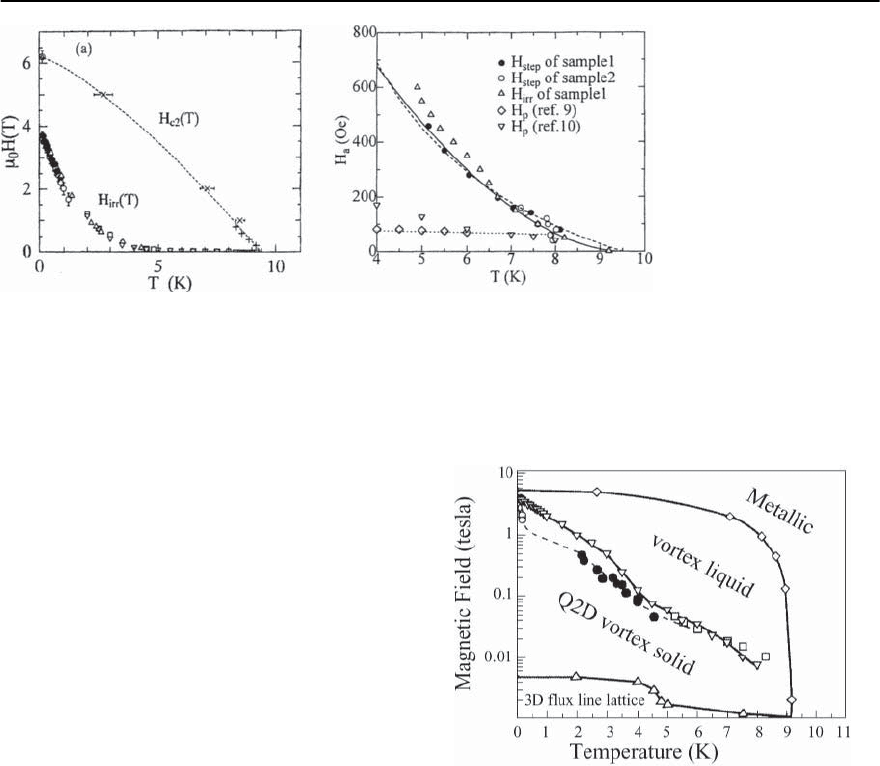
20 Organic Superconductors 1195
Fig. 20.36. Details of the B–T phase diagram for fields perpendicular to the conducting planes of -(ET)
2
Cu(NCS)
2
. Left
panel: temperature dependence of the irreversibility field and the upper critical field taken from [287]. Right panel:
first-order transition line (open and closed circles) determined by a step in the local induction. Solid and dashed curves
represent theoretical predictions for the melting and decoupling transitions, respectively, see text. Open diamonds and
down triangles indicate an anomalous second peak in magnetization associated with the dimensional-crossover field B
2D
of the vortex system,taken from [282]
high-T
c
cuprates [276,277], have been reported for
-(ET)
2
Cu(NCS)
2
[282, 288]. This refers to results
from micro Hall-probe experiments where the lo-
cal induction as a function of temperature at con-
stant fields shows step-like changes. As shown in
the right panel of Fig. 20.36 the first-order tran-
sition line can be fitted equally well by a melting
or a decoupling transition. Steps in the equilibrium
and local magnetization have been observed also
in SQUID and micro-hall-probe measurements, re-
spectively, for -(ET)
2
Cu[N(CN)
2
]Br [286, 289]. In
addition, Josephson-plasma-resonance experiments
revealed evidence that at the first-order transition,
the interlayer coherence becomes lost indicating that
the melting and the decoupling occur simultane-
ously [286].
Figure 20.37 shows in a semi-logarithmic plot the
B-T phase diagram for -(ET)
2
Cu(NCS)
2
as pro-
posed by [284]. Note that here the crossover field
B
2D
separating the 3D flux-line lattice
from the quasi-2D vortex solid is temperature de-
pendent in contrast to the results shown in Fig.20.36.
A first-order melting transition driven by quan-
tum fluctuations has been inferred from torque-
magnetization measurements at very low tempera-
tures [284].
An interesting situation arises when the magnetic
field is aligned parallel to the planes enabling the
Fig. 20.37. Mixed-state B-T phase diagram for -
(ET)
2
Cu(NCS)
2
for B ⊥ planes in a semi-logarithmic
representation. B
irr
is indicated by down triangles,the
dimensional-crossover field by up triangles. Open squares
denote a first order decoupling and/or melting transition.
Closed and open circles refer to thermal melting or depin-
ning and quantum melting transition from a quasi-2D vor-
tex lattice to a liquid phase, respectively, taken from [284]
vortices to slip in between the superconducting lay-
ers where the order parameter is small. For small tilt
angles of the field in respect to the exact alignment,
the vortex lattice can gain energy by remaining in
this parallel “lock-in” configuration. This new state
remains stable until the perpendicular field compo-
nent, B
⊥
, exceeds a threshold field at which the en-
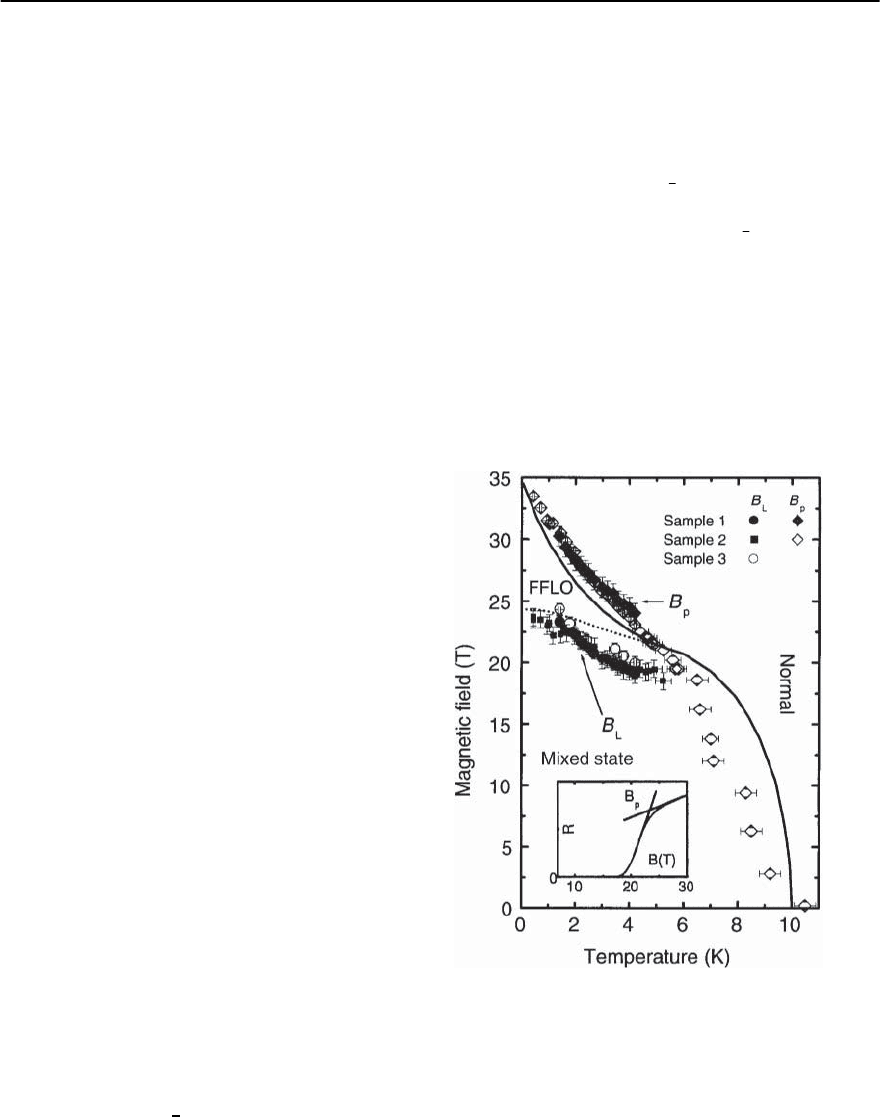
1196 M. Lang and J. M¨uller
ergy required to expel B
⊥
exceeds that associated
with the creation of normal cores in the layers. Evi-
dence for coreless Josephson vortices parallel to the
superconducting layers and a lock-in state has been
reported from ac-susceptibilitymeasurements for -
(ET)
2
Cu(NCS)
2
[264] and from torque magnetome-
try on -(ET)
2
Cu(NCS)
2
and -(ET)
2
Cu[N(CN)
2
]Br
[209,290], see also [9].
Further interest in the behavior of the present
quasi-2D organic superconductors in fields precisely
aligned parallel to the planes arose from the pro-
posal that these systems are possible candidates for
a Fulde–Ferrell–Larkin–Ovchinnikov (FFLO) state
[291]. Under suitable conditions, a spin-singlet su-
perconductor can reduce the pair-breaking effect of
a magnetic field by adopting a spatially modulated
order-parameter along the field direction [271,272].
The wavelength of the modulation is of the order
of the coherence length which results in a periodic
array of nodal planes perpendicular to the vortices
[271, 272]. In the case of an anisotropic supercon-
ductor, calculations show that the FFLO state might
lead to an enhancement of the upper critical field
to between 1.5 and 2.5 times the Pauli paramagnetic
limit [291,292].
By studying the magnetic behavior and the resis-
tivity of -(ET)
2
Cu(NCS)
2
in high magnetic fields
employing a tuned circuit differential susceptome-
ter,changes in the rigidity of the vortex arrangement
at certain fields B
L
within the superconducting state
have been found for fields precisely aligned parallel
to the planes [260,273]. These effects have been in-
terpreted as the manifestation of a phase transition
from the superconducting mixed state into an FFLO
state.
According to [271, 272], see also [294, 295], the
stabilization of a FFLO state requires: (i) a large
electronic mean free path l >
0
, i.e. clean limit,
(ii) a Pauli limiting that predominates the orbital
pair-breakingeffect,(iii)a Zeeman energy that over-
compensates the loss of superconducting condensa-
tion energy and (iv) a short coherence length (or
alargeGLparameter = /). As already dis-
cussed in Sect. 20.4.2, the criteria (i) and (iv) are
met for the present -(ET)
2
X salts. Condition (ii) is
fulfilled since H
P
=
1
2
H
c
(
Spin
)
−1/2
≈ 17 T is con-
siderably smaller than the orbital critical field as de-
rivedfrom (20.9)taking thevaluesfromTable20.2.To
check for condition (iii) one has to compare the Zee-
mann energy with the condensation energy. Using
Spin
=4· 10
−4
emu/mol for -(ET)
2
Cu(NCS)
2
[85]
and the upper critical field of 35 T yields a Zeeman-
energy density of E
Z
=
1
2
Spin
H
2
c
2
=5mJ/cm
3
(=
5 · 10
4
erg/cm
3
), which exceeds the condensation-
energy density of E
c
= H
2
c
/(8)=
1
4
· /V
mol
· T
2
c
=
1mJ/cm
3
(= 10
4
erg/cm
3
) calculated by employing
the experimentally determined Sommerfeld coeffi-
cient =(23± 1) mJ/mol K
2
for -(ET)
2
Cu(NCS)
2
[49,50].
Figure 20.38 shows the temperature dependence
of B
L
and B
P
, the latter serves as a rough estimate
of B
c
2
[260,273], see inset of Fig. 20.38. Comparing
the results with theoretical calculations derived for
a generic quasi-2D metal [293] (solid and dotted
Fig. 20.38. Magnetic field-temperature phase diagram of
-(ET)
2
Cu(NCS)
2
for B aligned parallel to the planes com-
pared with the theoretical FFLO phase diagram discussed
in [293]. B
P
as defined in the inset serves as a rough es-
timate for B
c
2
. B
L
indicates changes in the rigidity of the
vortex arrangement within the superconducting state. Re-
produced from [10,260]
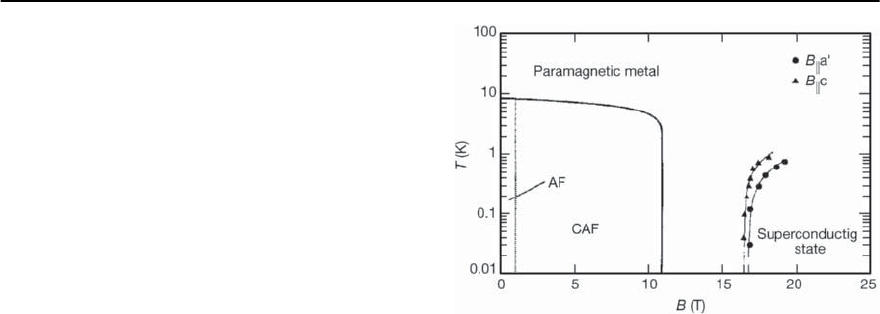
20 Organic Superconductors 1197
lines in Fig. 20.38) using the parameter B
c
2
(0) = 35 T
yielded a fairly good agreement with the predic-
tions of the FFLO model. In particular, the tem-
perature T
∗
belowwhichthenewstateisstabilized
was found to meet the theoretical predictions of
T
∗
=0.56 T
c
. However, recent magnetic torque mea-
surements failed to detect any indication for such
a transition [284]. Also, in studies of the critical
field under pressure using the tunnel diode oscillator
technique, no evidence for a FFLO phase has been
seen and the data suggest that -(ET)
2
Cu(NCS)
2
is
always Pauli limited [285].
20.4.4 Magnetic-Field-Induced Superconductivity
The -(BETS)
2
FeCl
4
systems has attracted strong
interest recently owing to the intriguing behavior
found when the system is exposed to a magnetic
field [296]. With increasing field aligned parallel to
the planes, the low-temperature antiferromagnetic
insulating state becomes suppressed and vanishes
above about 10 T. At higher fields the paramagnetic
metallic state which governs the B =0Tbehavior
above the N´eel temperature of about 10 K is restored.
For fields aligned exactly parallel to the highly con-
ducting planes, a further increase to above 17 T has
been found to induce a superconducting state at low
temperatures, see Fig. 20.39. For this field configura-
tion, the orbital effect is strongly suppressed so that
superconductivity is limited only by the Zeeman ef-
fect,i.e. the Pauli limit, resulting in a high upper crit-
ical field. The field-induced superconducting state
which is stable up to 41 T has been attributed to the
Jaccarino–Peter effect, where the external magnetic
field compensates the exchange field of the aligned
Fe
3+
moments [297]. The field-induced supercon-
ductivity is suppressed if the magnetic field is tilted
from the conducting plane.
In the concentration range 0.35 ≤ x ≤ 0.5of
the series -(BETS)
2
Fe
x
Ga
1−x
Cl
4
(cf. Fig. 20.27 in
Sect. 20.3.5), where superconductivity shares a com-
mon phase boundary with an antiferromagneti-
cally ordered insulating state, a field-induced afm
insulator-to-superconductor transition has been ob-
served [298]. It has been suggested that the pair-
Fig. 20.39.Temperature vs magnetic field phase diagram for
-(BETS)
2
FeCl
4
with the magnetic field aligned parallel to
the conducting planes. AF and CAF indicate the antiferro-
magnetic and canted antiferromagnetic phase,respectively
(taken from [296])
ing interaction arises from the magnetic fluctuations
through the paramagnetic Fe moments [296].
20.4.5 The Superconducting State: Pairing Mechanism
and Order-Parameter Symmetry
Understanding the nature of superconductivityin all
its variants continues to pose a challenging prob-
lem of enormous complexity. Elementary supercon-
ductors like Al or Zn are well described by the BCS
model [299] which envisages pairing between quasi-
particles in a relative zero angular momentum (L =
0) and spin-singlet (S = 0) state, with an attractive
pairing interaction mediated by the exchange of vir-
tual phonons. In the ground state, all electron pairs
(Cooper pairs) are in the same quantum-mechanical
state described by a single macroscopic wavefunc-
tion. Excitations, i.e. the creation of unpaired quasi-
particles, require an energy in excess of 2 ,where
is the energy gap, known as the order param-
eter. In the BCS model the gap amplitude (k)is
uniform over the whole Fermi surface. In addition,
the following quantitative relations are implied in
the BCS model: a universal ratio
0
/k
B
T
c
=1.76,
where
0
is the energy gap at zero temperature, and
C/ T
c
=1.43 with C being the jump height in the
specific heat at T
c
and the Sommerfeld coefficient.
In recent decades, novel classes of superconduc-
tors have been discovered in complex materials

1198 M. Lang and J. M¨uller
such as heavy-fermion metals [300], cuprates [301],
ruthenates [302] and the present organic materi-
als [1]. These systems have properties which are
markedly different from those of the simple elements
Al or Zn. The differences manifest themselves partic-
ularly clearly in the role of electron–electron interac-
tions, which are strong in the new superconductors
but of no relevance in the simple metals. The ques-
tion at hand is whether superconductivityin the new
materials is of a fundamentally different type to what
is described in the BCS model and proved valid to a
goodapproximation in so many superconductors.As
for the present organic materials this question covers
the following aspects
(i) Are the superconducting carriers “BCS-type”
pairs of electrons that form below T
c
(Cooper-
pairs)? Or do tightly boundelectron pairs preex-
ist already at higher temperatures T > T
c
which
undergo a Bose–Einstein condensation?
(ii) Is the relevant pairing mechanism different from
a conventional phononic mechanism? The ex-
change of antiferromagnetic spin fluctuations
as one of the models discussed for the high-T
c
cuprates and also for the present organic materi-
als is an example for an unconventional pairing
interaction.
(iii) Is the symmetry of the order parameter lower
than that of the Fermi surface? It is customary
to refer to an unconventional superconducting
state as one where the order parameter breaks at
least one of the crystal symmetries.
(iv) Is the spin part of the superconducting pair
wavefunctionanantisymmetricsingletorasym-
metric triplet state?
Although a local pairing scheme as distinguished
from the BCS-type pairing has been discussed also
for the present organic systems [303,304], the bulk
of experimental observations do not support such a
scenario. Rather the formation of Cooper-pairs be-
low T
c
implying an energy gap with a maximum
at T = 0 that vanishes for T ≥ T
c
has been widely
established, see e.g. [9].
The discussion of the above issues (ii)−(iv) in the
context of the organic superconductors is compli-
cated by the fact that even for the most fundamen-
tal properties contradictory experimental evidences
exist. Since some of these discrepancies might sim-
ply reflect extrinsic effects as a consequence of an
incomplete sample characterization, we shall there-
fore concentrate the discussion on those materials
which are best characterized and where most data
are available. These are the -phase (ET)
2
Xandthe
(TMTSF)
2
Xsalts.
On the Natureof the Superconducting State
The central question for the present organic super-
conductors concerns the nature of the pairing inter-
action. The excitonic mechanism proposed by Lit-
tle [3, 305] for certain quasi-1D organic polymers
was of great importance historically in giving the
initial impetus to the development of the field. From
today’s perspective, however, it is fair to say that the
search for materials with suitable chemical and phys-
ical properties for such a mechanism to work has
been unsuccessful so far.
In the discussion of the transport and optical
properties in Sect. 20.3.2 it became clear that there is
a substantial coupling of the charge carriers to both
intramolecular as well as intermolecular phonons.
Consequently, some researchers in the field believe
in a conventional electron–phonon coupling mecha-
nism. On the other hand, the fact that for the present
materials,as for the cuprates and heavy-fermion sys-
tems, the superconducting region in the phase dia-
gram lies next to a magnetically ordered state sug-
gests that magnetic interactions are involved in the
pairing mechanism.
Models Considering the Role of Phonons in the Pairing
Mechanism
One example for a conventional electron–phonon
pairing scenario has been discussed by Yamaji [306].
In this model he considers an attractive interaction
mediated by several high-frequency internal molec-
ular vibrations in addition to one low-frequency in-
termolecular phonon.
A more general account for the complex role of
phonons for superconductivity has been given by
Girlando et al. [59,307,308]. Bycalculating the lattice
phonons for the -(ET)
2
I
3
and ˇ-(ET)
2
I
3
supercon-
ductors using the quasi-harmonic-lattice-dynamics
method and evaluating the coupling to the electrons,

20 Organic Superconductors 1199
, they succeeded in reproducing all available ex-
perimental data related to the phonon dynamics, for
example the lattice specific heat. They showed that
a lattice mode that couples particularly strongly to
theelectronsisoneinwhichtherelativedisplace-
ment of the ET molecule is along the long axis of
the molecule, i.e. perpendicular to the conducting
planes. As an interesting side result of their study
on -(ET)
2
I
3
, it is mentioned, that the coupling of
acoustic phonons is very anisotropic and likely to
cause gap anisotropies, though of a conventional
type. In addition, it has been shown that the lat-
tice phonons alone cannot account for the T
c
values
in these compounds.High-frequencyintramolecular
phonons modulating the on-site electronic energies
have to be taken into accountto reproduce thecritical
temperatures [307].
Recently,a distinctkind of phonon-mediatedpair-
ing has been suggested for the (ET)
2
X salts [309].
It is based on the idea that in a system in which
Coulomb correlationsarescreened tobe short range,
i.e. Hubbard type, the electron–phonon scattering is
dominated by forward processes. This results in an
effective small-q pairing potential. Subsequent self-
consistent solutions of the BCS gap equation using
abandstructurebasedontheeffective-dimerap-
proximation, lead to a gap structure where d-wave
and anisotropic s-wave states are nearly degenerate.
Furthermore it has been argued that the conflicting
experimental results about the gap symmetry may
originate in the decorrelation of superconductivity
on various parts of the Fermi surface (a consequence
of small-q dominated pairing) and the near degen-
eracy of s-wave and d-wave superconducting gap
states [309].
Models That Consider a Magnetic Interaction
On the other hand, the rich phase diagram and the
anomalous properties of the metallic state of these
materials may suggest that the key elements domi-
nating the physical behavior are the layered struc-
ture and the strong interactions between the elec-
trons [4]. As a consequence, some researchers even
resign from considering any couplingto the phonons
and instead consider mechanisms which are solely
based on two-dimensional electronic interactions.
Most of these proposals deal with a spin-fluctuation-
mediated pairing mechanism. The latter is motivated
by the close proximity of the superconducting region
in the phase diagram to an antiferromagnetic insu-
lating state which,in analogy to the high-T
c
cuprates,
suggests that both phenomena are closely connected
to each other [4,238,310].
An approach in this direction has been proposed
by Kino and Fukuyama [238] who studied the effects
of on-site Coulomb interaction and dimer struc-
ture in a strictly two-dimensional system within the
Hartree–Fock approximation, see also [311]. In their
picture, the antiferromagnetic insulating state of -
(ET)
2
X is a Mott insulator. The Mott–Hubbard sce-
nario for the present organic superconductors im-
plies a half-filled conduction band, together with
strong electron correlations. Because of the approx-
imate square-lattice configuration of the dimers the
authors expect a similar spin-fluctuation mediated
superconductivity with probably d
x
2
−y
2
symmetry as
in the cuprates [238].
Such a possibility has been studied in detail by
Schmalian [310]. Using a two-band Hubbard model
to describe the antibonding orbitals on the ET dimer
he succeeded in creating a superconducting state
with T
c
10 K mediated by short-ranged antifer-
romagnetic spin fluctuations. It has been argued
that despite the frustrating interactionsand in-plane
anisotropies which distinguish the organic materi-
als from the high-T
c
cuprates, the origin of super-
conductivity is very similar for both material classes
[310].
A spin-fluctuation-based superconductivity sim-
ilar to that of the cuprates has been claimed also
by Kondo and Moriya [312–314]. They investigated
the properties of a half-filled Hubbard model in a
fluctuation exchange approximation (FLEX) with a
right-angle isosceles triangular lattice with transfer
matrices −
and −. They revealed an energy gap
of d
x
2
−y
2
symmetry which upon cooling grows much
faster compared to that expected in the BCS model.
In addition they showed, that the appearance of d-
wave superconductivity near an antiferromagnetic
instabilityrequiresa suitableelectronicstructure,i.e.
/ > 0.3 [239,312,313].
